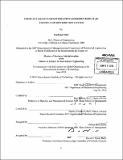Crisplant defects quantification and reduction at an amazon.com distribution center
Author(s)
Patel, Kashyap (Kashyap C.)
DownloadFull printable version (10.34Mb)
Alternative title
Crisplant defects quantification and reduction
Other Contributors
Leaders for Global Operations Program.
Advisor
Roy Welsch and Stanley Gershwin.
Terms of use
Metadata
Show full item recordAbstract
Crisplant is a tilt-tray sortation system used in Reno (RNO 1) fulfillment center (FC) to group items by customer orders. On average., crisplant processes about 80% of the total outbound volume through its multipart operation flow. Because of high volume and complex process flow, the majority of defects, in RNO 1 FC. are seen in crisplant costing distribution center (RNO 1) significantly in labor hours. This research paper identifies and quantifies the major defects in crisplant, and outlines the solutions to reduce the cost of handling these defects in RNO 1. The project work thoroughly assesses the entire RNO 1 crisplant operations (induct, sort, pack, SLAM, and problem solve) through four-phase approach: Understand the crisplant Process Flow, Develop a Data Collection Framework, Collect and Analyze Data, and Identify/Implement Data Driven Solutions. Lean principles and methodologies were used throughout the project work especially when identifying solutions. For example, opportunities that improved the packing process were identified based on a deep-dive analysis as a part of the Kaizen study. The project results demonstrated 50% reduction in cost of handling crisplant defects in RNO l. Furthermore, it highlighted opportunities for additional savings by identifying solutions that can also be implemented in other FCs (i.e. SDF 1, TUL 1) with similar operation as RNO 1.
Description
Thesis (M.B.A.)--Massachusetts Institute of Technology, Sloan School of Management; and, (S.M.)--Massachusetts Institute of Technology, Dept. of Mechanical Engineering; in conjunction with the Leaders for Global Operations Program at MIT, 2010. Cataloged from PDF version of thesis. Includes bibliographical references (p. 59-60).
Date issued
2010Department
Leaders for Global Operations Program at MIT; Massachusetts Institute of Technology. Department of Mechanical Engineering; Sloan School of ManagementPublisher
Massachusetts Institute of Technology
Keywords
Sloan School of Management., Mechanical Engineering., Leaders for Global Operations Program.